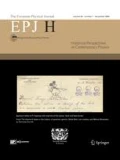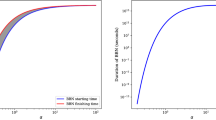Abstract
During the two decades before World War I, many physicists, astronomers and earth scientists engaged in interdisciplinary research projects with the aim of integrating terrestrial, solar and astronomical phenomena. Under the umbrella label “cosmical physics” they studied, for example, geomagnetic storms, atmospheric electricity, cometary tails and the aurora borealis. According to a few of the cosmical physicists, insights in solar-terrestrial and related phenomena might be extrapolated to the entire solar system or beyond it. Inspired by their research in the origin and nature of the aurora, Kristian Birkeland from Norway and Svante Arrhenius from Sweden proposed new theories of the universe that were of a physical rather than astronomical nature. Whereas Birkeland argued that electrons and other charged particles penetrated the entire universe – and generally that electromagnetism was of no less importance to cosmology than gravitation – Arrhenius built his cosmology on the hypothesis of dust particles being propelled throughout the cosmos by stellar radiation pressure. Both of the Scandinavian scientists suggested that the universe was infinitely filled with matter and without a beginning or an end in time. Although their cosmological speculations did not survive for long, they are interesting early attempts to establish physical cosmologies and for a while they attracted a good deal of attention.
Similar content being viewed by others
References
Abbe, C. 1911. The meteorology of the future. Pop. Sci. Month. 78: 21-35
Alfvén, H. 1950. Cosmical Electrodynamics. Clarendon Press, Oxford
Anderson, J.A. 1908. The work of Prof. Carl Störmer on Birkeland’s theory of the aurora borealis. Month. Weather Rep. 36: 129-131
Arrhenius, G. 1959. Svante Arrhenius’ contributions to earth science and cosmology. In Svante Arrhenius, till 100-Årsminnet av hans Födelse. Almqvist & Wiksell, Uppsala, pp. 67-81
Arrhenius, S. 1900. Über die Ursache der Nordlichter. Physik. Zeits. 2: 81-87, 97-105
Arrhenius, S. 1901. Zur Kosmogonie. Arch. Sci. Phys. Nat. 6: 862-873
Arrhenius, S. 1903a. On the electric equilibrium of the sun. Month. Not. Roy. Astron. Soc. 64: 496-499
Arrhenius, S. 1903b. Lehrbuch der kosmischen Physik. Hirzel, Leipzig
Arrhenius, S. 1903c. Die Verbreitung des Lebens im Weltenraum. Die Umschau 7: 481-485
Arrhenius, S. 1904. On the physical nature of the solar corona. Astrophys. J. 20: 224-231
Arrhenius, S. 1906. The relation of meteorology to other sciences. In International Congress of Arts and Sciences: Astronomy and Earth Sciences, edited by Howard J. Rogers. University Alliance, London, Vol. 3, pp. 733-740
Arrhenius, S. 1908. Worlds in the Making: The Evolution of the Universe. Harper & Brothers, New York
Arrhenius, S. 1909. Die Unendlichkeit der Welt. Scientia 5: 217-229
Arrhenius, S. 1912. Die Verteilung der Himmelskörper. Meddel. Kungl. Vetenskapsakad. Nobelinstitut 2: no. 21
Arrhenius, S. 1914. Das Milchstrassenproblem. Scientia 15: 349-363
Augur, A.W. 1901. [Review of Arrhenius’ theory of the aurora]. Astrophys. J. 13: 344-347
Berny, A. 1913. Über kosmische Entwicklung. Das Weltall 13: 317-324
Birkeland, K. 1895. Solution générale des équations de Maxwell pour un milieu absorbant homogène et isotrope. Comptes Rendus 12: 1046-1050
Birkeland, K. 1896. Sur les rayons cathodiques sous l’action de forces magnétiques intenses. Arch. Sci. Phys. Nat. 1: 497-512
Birkeland, K. 1901. Expédition norvégienne de 1899-1900 pour l’étude des auroras boréales. Videnskabsselskabets Skrifter, I, no. 1: 1-180
Birkeland, K. 1908. The Norwegian Aurora Polaris Expedition 1902-1903, H. Aschehoug & Co., Christiania, Vol. 1, Section 1
Birkeland, K. 1911. Les anneaux de Saturne sont-ils dus à une radiation électrique de la planète? Comptes Rendus 153: 375-377
Birkeland, K. 1913a. The Norwegian Aurora Polaris Expedition 1902-1903, H. Aschehoug & Co., Christiania, Vol. 1, Section 2
Birkeland, K. 1913b. The origin of worlds. Sci. Am., Suppl. 76: 7-9, 12, 20-22
Birkeland, K. 1913c. De l’origine des mondes. Arch. Sci. Phys. Nat. 35: 529-564
Birkeland, K. 1916. Les rayons corpusculaires du soleil qui pénètrent dans l’atmosphère terrestre: sont-ils négatifs ou positifs? Arch. Sci. Phys. Nat. 41: 22-37, 108-124
Block, L. 1955. Model experiments on aurorae and magnetic storms. Tellus 7: 65-86
Borowitz, S. 2008. The Norwegian and the Englishman. Phys. Persp. 10: 287-294
Clerke, A.M. 1903. Problems in Astrophysics. Adam & Charles Black, London
Clerke, A.M. 1905. Modern Cosmogonies. Adam & Charles Black, London
Cox, J. 1902a. Comets’ tails, the corona and the aurora borealis. Pop. Sci. Month. 60, 266-278
Cox, J. 1902b. On prof. Arrhenius’ theory of cometary tails and auroræ. Nature 66: 54-56
Crawford, E. 1996. Arrhenius: From Ionic Theory to the Greenhouse Effect. Science History Publications, Canton, MA
Crawford, E. 1997. Arrhenius’ 1896 model of the greenhouse effect in context. Ambio 26, no. 1: 6-11
Crawford, E. 2002. The Nobel Population 1901-1950. A Census of the Nominators and Nominees for the Prizes in Physics and Chemistry. Universal Academy Press, Tokyo
Dick, S.J. 1996. The Biological Universe: The Twentieth-Century Extraterrestrial Life Debate. Cambridge University Press, Cambridge
Egeland, A. and W.J. Burke. 2010. Kristian Birkeland: The First Space Scientist. Springer, Dordrecht
Egeland, A. and W.J. Burke. 2013. Carl Størmer: Auroral Pioneer. Springer, Berlin
Ekholm, N. 1902. Die Extinktion des Lichtes im Weltall. Met. Zeits. 19: 242-244
Friedman, R.M. 1995. Civilization and national honour: The rise of Norwegian geophysical and cosmic science. In Making Sense of Space: The History of Norwegian Space Activities, edited by J.P. Collett. Scandinavian University Press, Oslo, pp. 3-40
Friedman, R.M. 2001. The Politics of Excellence: Behind the Nobel Prize in Science. W.H. Freeman, New York
Goldstein, E. 1881. Ueber die Entladung der Elektricität in verdünnten Gasen. Ann. Phys. 12: 249-279
Halm, J. 1902. On prof. Arrhenius’ theory of cometary tails and auroræ. Nature 65: 415-416; 66: 55-56
Hammerl, C., W. Lenhardt, R. Steinacker and P. Steinhauser, eds. 2001. Die Zentralanstalt für Meteorologie und Geodynamik: 150 Jahre Meteorologie und Geophysik in Österreich. Leykam Buchverlagsgesellschaft, Graz
Hedenus, M. 2007. Der Komet in der Entladungsröhre: Eugen Goldstein, Wilhelm Foerster und die Elektrizität im Weltraum. GNT-Verlag, Stuttgart
Hirsh, R.F. 1985. Glimpsing the Invisible Universe: The Emergence of X-ray Astronomy. Cambridge University Press, Cambridge
Holmberg, G. 1999. Reaching for the Stars: Studies in the History of Swedish Stellar and Nebular Astronomy. Ugglan, Lund
Jago, L. 2001. The Northern Lights: The True Story of the Man Who Unlocked the Secrets of the Aurora Borealis. Alfred A. Knopf, New York
Jørgensen, T.S. and O. Rasmussen. 2006. Adam Paulsen, a pioneer in auroral research. EOS 87, no. 6: 61-66
Kamminga, H. 1982. Life from space – a history of panspermia. Vistas Astron. 26: 67-86
Kragh, H. 1995. Cosmology between the wars: The Nernst-MacMillan alternative. J. Hist. Astron. 26: 93-115
Kragh, H. 2007a. Conceptions of Cosmos. From Myths to the Accelerating Universe: A History of Cosmology. Oxford University Press, Oxford
Kragh, H. 2007b. Cosmic radioactivity and the age of the universe, 1900-1930. J. Hist. Astron. 38: 393-412
Kragh, H. 2008. Entropic Creation: Religious Contexts of Thermodynamics and Cosmology. Ashgate, Aldershot
Kragh, H. 2009. The spectrum of the aurora borealis: From enigma to laboratory science. Hist. Stud. Nat. Sci. 39: 377-417
Kragh, H. 2012. Is space flat? Nineteenth-century astronomy and non-Euclidean geometry. J. Astron. Hist. Heritage 15: 149-158
Kragh, H. 2013. The rise and fall of cosmical physics: Notes for a history, ca. 1850-1920. Arxiv: 1304.3890 [physics.hist-ph]
Kragh, H. and B. Carazza. 1990. Augusto Righi’s magnetic rays: A failed research program in early 20th-century physics. Hist. Stud. Phys. Sci. 21: 1-28
Langmuir, I. 1928. Oscillations in ionized gases. Proc. Natl. Acad. Sci. 14: 627-637
Lockyer, W.J. 1894. Text-book of cosmical physics. Nature 50: 49-50
Malmfors, K.G. 1946. Experiments on the aurorae. Ark. Mat. Astr. Fys. B 34: 1-8
Morrisson, Mark S. 2007. Modern Alchemy: Occultism and the Emergence of Atomic Theory. Oxford University Press, Oxford
Mott-Smith, H.M. 1971. History of “plasmas.” Nature 233: 219
Müller, J. and C.F.W. Peters. 1894. Joh. Müller’s Lehrbuch der kosmischen Physik. Vieweg und Sohn, Braunschweig
Norton, J.D. 1999. The cosmological woes of Newtonian gravitation theory. In The Expanding World of General Relativity, edited by Hubert Goenner et al. Birkhäuser, Boston, pp. 271-324
Oberkofler, G. et al. 1990. 100 Jahre Institut für Meteorologie und Geophysik (Kosmische Physik) der Leopold-Franzens-Universität Innsbruck. Wagnerschen Universitätsbuchhandlung, Innsbruck
Paul, E.P. 1993. The Milky Way Galaxy and Statistical Cosmology 1890-1924. Cambridge University Press, Cambridge
Paulsen, A. 1906. Sur les récentes theories de l’aurore polaire. Bull. l’Acad. Roy. Sci. Danemark 2: 109-144
Peratt, A.L. 1985. Birkeland and the electromagnetic cosmology. Sky & Telescope 69: 389-391
Peratt, A.L. 1995. Introduction to plasma astrophysics and cosmology. Astrophys. Space Sci. 227: 3-11
Poincaré, H. 1896. Remarques sur une expérience de M. Birkeland. Comptes Rendus 123: 530-533
Poincaré, H. 1911. Leçons sur les Hypothèses Cosmogoniques. A. Hermann, Paris
Poincaré, H. 1913. Dernières Pensées. Flammarion, Paris
Potemra, T.A. 1988. Birkeland currents in the Earth’s magnetosphere. In Plasma in the Universe, edited by C.-G. Fälthammar et al. Springer, Berlin, pp. 155-169
Romer, R.H. 1982. Alternatives to the Poynting vector for describing the flow of electromagnetic energy. Am. J. Phys. 50: 1166-1168
Rypdal, K. and T. Brundtland. 1997. The Birkeland terrella experiments and their importance for the modern synergy of laboratory and space plasma physics. J. Physique IV 7, C4: 113-132
Schuster, A. 1911. On the origin of magnetic storms. Proc. Roy. Soc. 85: 44-50
Schwarzschild, K. 1913. [Review of Poincaré, 1911]. Astrophys. J. 37: 294-298
Schwarzschild, K. 1992. Der Druck des Lichts auf kleine Kugeln und die Arrhenius’sche Theorie der Cometenschweife. In Karl Schwarzschild. Gesammelte Werke, Vol. 1, edited by H.H. Voigt. Springer Verlag, Berlin, pp. 317-322
Snyder, C. 1907a. New epic of creation. New York Times, 6 July
Snyder, C. 1907b. The World Machine. The First Phase: The Cosmic Mechanism. Longmans, Green, and Co., London
Stubhaug, A. 2010. Gösta Mittag-Leffler: A Man of Conviction. Springer-Verlag, Berlin
Størmer, C. 1917. Corpuscular theory of the aurora borealis. Terrestr. Magn. Atm. Electr. 22: 23-34
Størmer, C. 1955. The Polar Aurora. Clarendon Press, Oxford
Thomson, J.J. 1897. Cathode rays. Phil. Mag. 44: 296-314
Thomson, J.J. 1901. The existence of bodies smaller than atoms. Proc. Roy. Inst. 16: 138-150
Thomson, J.J. 1903. Conduction of Electricity through Gases. Cambridge University Press, Cambridge
Trabert, W. 1911. Lehrbuch der kosmischen Physik. B.G. Teubner, Leipzig
Walter, S., ed. 2007. La Correspondance entre Henri Poincaré et les Physiciens, Chimistes et Ingénieurs. Birkhäuser, Basel
Worrall, J. 1982. The pressure of light: The strange case of the vacillating “crucial experiment.” Stud. Hist. Phil. Sci. 13, 133-171
Author information
Authors and Affiliations
Corresponding author
Rights and permissions
About this article
Cite this article
Kragh, H. Nordic cosmogonies: Birkeland, Arrhenius and fin-de-siècle cosmical physics. EPJ H 38, 549–572 (2013). https://doi.org/10.1140/epjh/e2013-40014-0
Received:
Revised:
Published:
Issue Date:
DOI: https://doi.org/10.1140/epjh/e2013-40014-0




